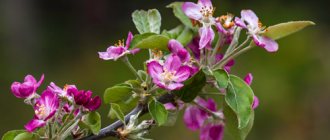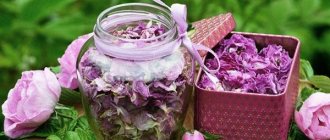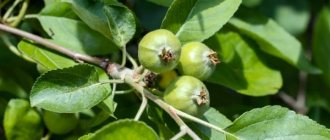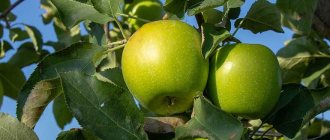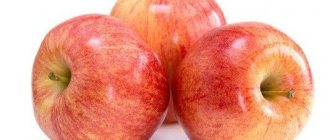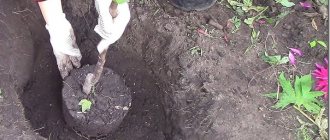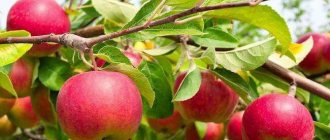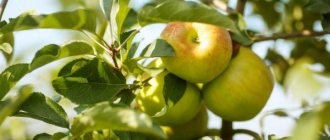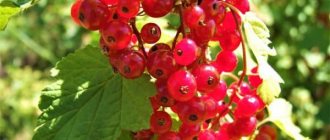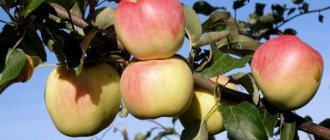A little history
It is believed that red-fleshed apple trees carry the genes of the Niedzwiecki apple tree, known for its decorative effect throughout the growing season. The Niedzvetsky apple tree has a purple coloring of shoots, leaves, petioles, flowers and even the pulp of small apples. The first apples with pink flesh were obtained by I.V. Michurin himself, who simply rejected them, considering such properties unacceptable for many varieties. Despite this, Michurin continued to work on crossing various varieties with the Nedzvetsky apple tree to obtain winter-hardy dessert cultivars. As a result, the Yakhontovoye variety with the original dark pink color of the apple pulp appeared, and subsequently the Bellefleur Red variety, the apples of which have pinkish pulp and a pinkish seed nest under the skin. To develop apple varieties with red flesh, modern breeders are simply continuing the work begun decades ago by the scientist Michurin.
Red apple tree: specifics of varieties
Photo of the variety "Baya Marisa"
- The first and most important thing is that all fruit-bearing trees with reddish inflorescences, foliage and apples come from an uncultivated variety - the Niedzvetsky apple tree. The newer varieties, with red flesh inside, maintain most of the characteristics of the parent variety. However, in some characteristics it is overtaken. For example, by the accelerated process of fruit ripening, taste, yield and appearance.
- Second and no less important is that it is recommended to plant these trees in moist and saturated soil. Fruit-bearing trees with apples, which have multi-colored pulp inside, give their preference to dark gray forest lands and black soils. In terms of mechanical composition, light and medium loamy soils are suitable. It is extremely important that the carbonates contained in the ground in areas up to eighty centimeters deep do not reach a limit of more than ten to twelve percent.
- The third thing is that at the time of planting, the planting material should be placed before the grafted area. Along the edges of the planting hole, it is necessary to make sides ten to fifteen centimeters high to facilitate moisture so that the liquid reaches the root system. These fruit-bearing trees should be moistened once every fourteen days.
- The fourth is that, unlike other fruit-bearing trees, in red-fleshed apple trees all phases of growth and development of planting material occur at a slightly delayed time. This means that the buds open late, and the branches also begin to grow much later. And all because in the first weeks, apple trees develop exclusively a root system. However, after some time, they begin to bear fruit abundantly (the fruits can be harvested when the tree reaches two years of age).
- Fifth, the flowering process begins earlier on shoots growing in the lower part of the tree than on shoots growing in the upper part of the tree. This means that in fruit-bearing trees the flowering process lasts much longer than standard ones.
- Sixth, it is possible to harvest large quantities of crops from fruit-bearing trees in years when the winter period is not very cold and there are no sharp temperature changes in the spring season.
Features of apple trees with red fruits
In addition to the anthocyanin color of apple pulp, apple trees have other features:
- red-fleshed fruits do not lose their unusual color when cooked;
- wood, young leaves, flowers have a pinkish or bright red color;
- flowering is always uneven, starting from the lower branches and gradually rising to the top, so the ten-day flowering period can last for a month;
- all phases of growth and development of seedlings proceed more slowly and at a later date. In the first year, yearlings spend their energy mainly on the formation of the root system. The slow development of the seedling in the first year is compensated by the early onset of fruiting - in the second or third year;
- red bark attracts the attention of rodents, especially mice, to the tree. Therefore, it is imperative to protect the trunk from rodents using a plastic mesh;
- Red-fleshed apples contain 20-30% more antioxidants than regular apples, for which they are often called rejuvenating.
Red apple tree
Saying “thank you” to breeding specialists today, we have many options for planting these fruitful trees, which produce apples not only with white flesh, but also purple, reddish, and pinkish. Which varieties are better to give preference? Apples, reddish inside, are completely unfamiliar to us in taste and smell, and on top of that they also contain a whole list of vitamins and beneficial microelements that increase immunity. In the varieties of red meat apples listed below, the content of vitamins, beneficial microelements and antioxidants is much higher than in the apples that we have long been accustomed to eating. And the most interesting thing is that the reddish color is not lost at all even after heat treatment of the product. This article describes the red apple tree.
Description of varieties
Unfortunately, fruit nurseries focus their work on promoting varieties of apples with pink flesh, mainly from foreign selection, because the targeted breeding of red-fleshed apple trees is mainly carried out by foreign breeders. But often behind the beautiful wrapper there is a tasteless “something” bought for a lot of money. Therefore, before purchasing, you should familiarize yourself with the characteristics of the assortment, which is distinguished by the most valuable taste and commercial qualities.
All red-fleshed cultivars are characterized by high early fruiting, good winter and frost resistance, and are resistant to scab.
Baya Marisa is an early winter German variety obtained in 2009. The apples are large, red with white dots. The juicy red pulp has a sweet and sour taste and a faint aroma. Harvesting takes place in September, apples are stored until January.
Baya Marisa apples.
Pink Pearl is an apple variety from sunny California, bred in 1944. When breeding it, genetic material from the Niedzwiecki apple tree was used. It differs from other red-fleshed varieties by the unusual combination of color of the apple skin and its pulp. The skin is greenish-yellow, and the highly aromatic core is bright pink. The apples are very juicy, tart, reminiscent of both the taste of raspberries and grapefruit. Harvested at the end of August and stored until December.
Apple Pink Pearl.
Vinerpo is a winter variety from Argentina. Large dark red apples with purple stripes, red-pink inside, juicy, sweet and sour. The harvest is harvested at the end of September and stored until January-February.
Apple tree Vinerpo.
Jersey is an early winter variety. The fruits are large, with red skin. The apple pulp is dark pink in color, very juicy, crispy, with a pleasant sweet-sour taste and light aroma. Harvesting maturity occurs at the end of September and is stored until January.
Jersey apple variety.
Red Passion is a new late-summer variety. The apples are medium-sized with bright red skin and dark pink inside. The pulp is juicy, crispy, with a pronounced berry taste. Removable maturity - end of August, storage until October. The tree is compact in size and very decorative. Scab resistance is high.
Red Passion apple variety.
Trinity is a late summer apple variety with dark pink flesh and a dessert flavor. The tree is high-yielding, compact in size, suitable for small areas, has good winter hardiness and resistance to fungal infections. Trinity apple juice is dark pink in color and its properties are identical to pomegranate juice.
Cross-section of a Trinity apple.
There are several cultivars of domestic selection that can be called pink-fleshed.
Bellefleur red - in 1915 created by I.V. Michurin by hybridizing Bellefleur Kitayka and Yakhontovy. The hybrid was grafted into the crown of the Niedzwiecki apple tree, from which it received decorative properties in the form of reddish wood and leaves. Subsequently, the resulting form was grown independently. The fruits have an almost purple skin color and a pink color under the skin and around the seed nest. The taste is pleasant, sour. The tree is completely insensitive to cold.
Apple tree Bellefleur red.
Red early is an early summer variety of Russian selection, bred at the scientific center named after. I.V. Michurina and included in the State Register of the Russian Federation in 1994. The apples are smaller than average in size, bright red, and the flesh under the skin is pink. The taste is sweet and sour, slightly aromatic, dessert. Technical maturity occurs at the end of July - beginning of August; storage in the refrigerator for two to three weeks is allowed.
Red early apple variety.
Elite 6m-1-3 is a winter variety bred by S.I. Isaev by crossing Slavyanka and Mekintosh. Compact tree up to two meters high, beautifully flowering. The fruits are medium in size, with a blurred blush. The pulp is pink, juicy, with a pleasant sour-sweet taste. Ripening at the end of September, storage until April.
Apples Elite.
Early varieties of red apples
Early, or summer, red varieties of apples are usually immediately eaten fresh. They are not stored for long-term storage, since their shelf life is low. But they are often used for processing, winter preservation, and sale.
- "Vista Bella" is an early summer variety of red apples. The tree is tall, with a large crown. Fruits are 150-200 g, round, flattened on top. The peel is dense, red with a light dot. There may be some small yellow-green spots, but this is rare. The pulp is white, the taste is sweet and sour. There is average resistance to frost.
Early varieties of red apples
Mid-ripening red apple varieties
Mid-ripening red varieties of apples do not last long - 1-3 months. At the same time, they can be closed for the winter, frozen, but more often they are eaten raw or baked - they are very tasty and tender in texture.
- “Mackintosh”, also known as “Mackintosh”, is one of the most popular varieties in Canada and the USA. In Europe it is often called “autumn Khoroshovka” or “autumn excellent”. Named after its creator John Mackintosh. Ripens from late August to early September. The fruits average 140-160 g. The skin is almost completely red, but there are yellow-green spots. The pulp is juicy, sweet and sour, white. The aroma is strong, apple. Transportability is good, as is frost resistance. May be affected by diseases.
Mid-ripening red apple varieties
Ripening and fruiting of the Pink Pearl apple tree
Beginning of fruiting
Pink pearls are considered early-bearing, because the first flowers appear on it already 2-3 years after planting in open ground. However, it is advisable to cut them off immediately. A harvest of 5-15 kilograms can be harvested for the first time in 4-5 years.
Flowering time
The variety blooms quite early, around the beginning of May, but much will depend on the climate and weather. The apple tree looks amazing during flowering, as it has large pink inflorescences that densely cover the branches. The aroma when flowering is average, but very unusual, with spicy and even slightly citrus notes.
Fruiting and growth
Pink pearls begin to bear fruit normally only at 8-10 years of age. Then it will be possible to remove 70-80 or more kilograms of juicy, ruddy fruits. They ripen at the end of August or beginning of September. You need to try not to miss the moment, otherwise they may fall to the ground and will need to be processed immediately, within a few days.
These apples generally do not lend themselves well to storage, although they can be transported. In about 3-5 weeks, they completely lose their original taste, juiciness, and become loose. Therefore, by that time it is better to eat them or process them into juice, jams, preserves.
Top dressing
- Bird droppings.
- Manure.
- Compost.
- Humus.
- Ammonium nitrate.
- Urea.
- Superphosphate.
- Mineral complexes.
What to do if it doesn’t bloom or bear fruit
- Water or stop watering.
- Add fertilizer.
- Replant to a sunnier location.
- Check for pests or diseases.
- Provide watering.
Why do apples fall
- Overripe.
- Lack or excess of water.
- Natural phenomena (wind, rain, hail).
- Diseases.
- Pests.
Leave reviews about the Pink Pearl apple tree in the comments, and share your own experience with other gardeners.
Previous
Apple tree varieties
